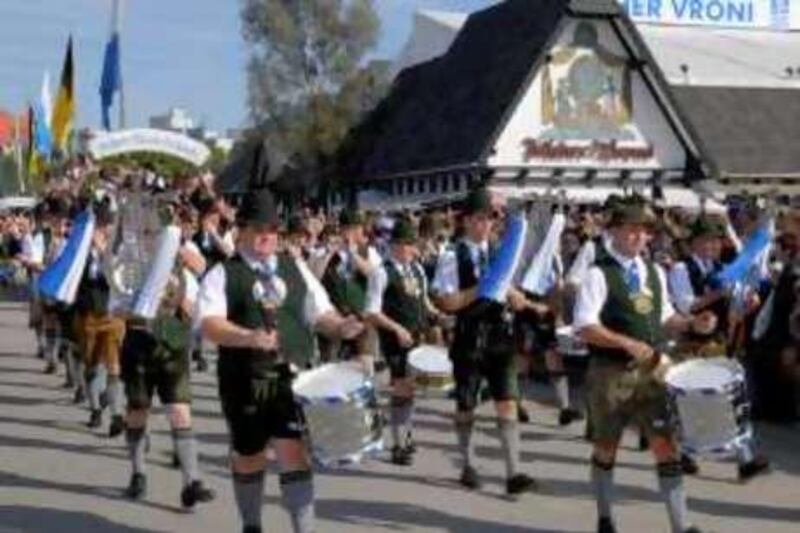Berlin // Bavaria's proud culture is under threat from cheap imported lederhosen and Dirndl dresses made in China, India and eastern Europe, heritage groups have warned ahead of the opening tomorrow of the Munich Oktoberfest, the world-famous festival that draws six million visitors each year. The men's short leather trousers and the women's country dresses with frilly white blouses worn by many of the revellers at the festival are mere "pseudo folk costumes" that lack the quality of homemade garments, said the Federation of Bavarian Folk Costume Societies.
Department stores and fashion boutiques in the Bavarian capital of Munich have admitted that many of the outfits on sale are made from imported leather and fabrics, or are manufactured abroad to save costs. Purists frown on such sacrilege. "You can't import local tradition," said Hans Lehrer a spokesman for the Federation. "Costumes should be manufactured where they're worn. Local customs come from one's homeland, and I'm against people wearing lederhosen from Romania just because they're cheaper."
The raucous two-week Oktoberfest, with its giant tents, traditional oompah bands, yodelling and thigh-slapping dances, is the high point of Bavaria's social calendar and projects the region's heritage and joie de vivre around the world. While 15 per cent of its visitors come from abroad, almost three quarters are from Munich and the surrounding area, and most locals wear traditional costumes when attending.
Given the price of Bavarian-made outfits, however, it is not surprising many opt for imported wear. "A deer leather embroidered Lederhose made by one of our traditional tailors will cost from ?600 [Dh3,200] upwards," Mr Lehrer said. "But it will last you your whole life if you don't get too fat. It's wonderful, like a second skin." Foreign-made lederhosen are far cheaper at about ?150. Alexander Wandinger, an authority on Bavarian folk dress, said: "You get cheap lederhosen made in India and all over the place. That kind of outfit may be fine for the Oktoberfest but it has nothing to do with folk costume."
Low-cost foreign competition had forced many German textile firms out of business over the years and had also hit Bavaria's costume makers, said Mr Wandinger, head of the Bavarian Folk Costume Information Centre, which researches Bavarian heritage and gives advice on where to buy true folk costumes. He said there were fewer than 100 true lederhosen makers left in Bavaria now. The costumes of fine lace and embroidered leather derive from the clothes worn by the mountain farmers of this Alpine region of Germany, but they are less ancient than one might think.
Many designs stem from the 19th century when they became fashionable among the Bavarian and Austrian aristocracy as national pride surged across Europe. Dozens of folk societies were set up at that time to develop their own costumes and to stage dress parades at festivals across Bavaria, including the Oktoberfest. Few would deny that Bavaria's heritage is worth protecting. The region, with its onion-domed churches and stunning mountains, has a wholesome image and has helped shape Germany's national identity.
Yet despite the warnings from folk groups, there is little evidence that the region's culture is in imminent danger. The costume societies continue to thrive, with a membership totalling an impressive 200,000 registered adults and 100,000 children. Munich alone has 38 such societies, and at the opening weekend of the Oktoberfest each year, Bavaria's folk groups stage a huge procession with 9,000 participants showing off lederhosen and Dirndls that are very definitely Made in Bavaria. Television networks broadcast the parade live.
"There seems to be an increased yearning for security, which expresses itself in a search for regional identity and tradition," Mr Wandinger said. The Oktoberfest itself has been trying to become more traditional. In the past three years the city of Munich, which organises the festival, has ordered the bands in the 14 tents, some of which seat up to 10,000 people, to play more traditional music and to keep the volume down.
The change was a response to complaints from older visitors that the festival was turning into a disco and losing its Bavarian character. "Before six o'clock the bands aren't allowed to play rousing modern music and they have to keep the noise down below 85 decibels," said Gabriele Papke, a spokeswoman for the festival. "It's definitely given the festival a more traditional feel again and I've also noted that ever more people, young and old, are wearing Bavarian costumes."
The Oktoberfest dates back to the wedding in Oct 1810 of Bavarian Crown Prince Ludwig with Princess Therese of Saxony-Hildburghausen. The public festivities went on for five days and proved so popular they were repeated every year since, except in wartime and during two cholera epidemics. Oktoberfest Dirndl fashions on sale in Munich stores change from year to year with slight variations in pattern, cut and colour, and Munich women compete with each other to keep up with the trends.
Otto Dufter, the chairman of the Federation Bavarian Folk Costume Societies, said the big department stores were undermining Bavarian culture and that the "yuppie costumes" worn by city folk at the Oktoberfest had nothing to do with true Bavarian costume. But he did praise the organisers for keeping the volume down. "The festival has done more to promote the Bavarian nature of the festival in recent years," Mr Dufter said.
Even the purists expect that Bavaria's culture is strong enough to cope with imported lederhosen. "As long as we have our mountains and people keep on living up there, our traditions won't die," Mr Lehrer said. "The countryside shapes the people, and Bavaria happens to be the most beautiful part of Germany. Bavarian culture is simply Number One in Germany." @Email:dcrossland@thenational.ae






